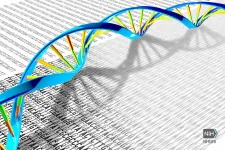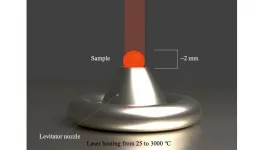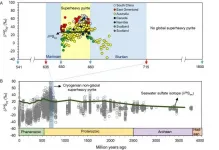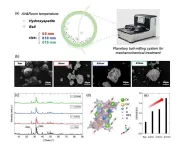(Press-News.org) An investigational gene therapy can safely restore the immune systems of infants and children who have a rare, life-threatening inherited immunodeficiency disorder, according to research supported in part by the National Institutes of Health. The researchers found that 48 of 50 children who received the gene therapy retained their replenished immune system function two to three years later and did not require additional treatments for their condition, known as severe combined immunodeficiency due to adenosine deaminase deficiency, or ADA-SCID. The findings were published today in the New England Journal of Medicine.
ADA-SCID, which is estimated to occur in approximately 1 in 200,000 to 1,000,000 newborns worldwide, is caused by mutations in the ADA gene that impair the activity of the adenosine deaminase enzyme needed for healthy immune system function. This impairment leaves children with the condition highly susceptible to severe infections. If untreated, the disease is fatal, usually within the first two years of life.
"These findings suggest that this experimental gene therapy could serve as a potential treatment option for infants and older children with ADA-SCID," said Anthony S. Fauci, M.D., director of NIH's National Institute of Allergy and Infectious Diseases (NIAID). "Importantly, gene therapy is a one-time procedure that offers patients the hope of developing a completely functional immune system and the chance to live a full, healthy life."
People with ADA-SCID can be treated with enzyme replacement therapy, but this treatment does not fully reconstitute immune function and must be taken for life, usually once or twice weekly. Transplants of blood-forming stem cells, ideally from a genetically matched sibling donor, can provide a more lasting solution. However, most people lack such a donor. Additionally, stem cell transplants carry risks such as graft-versus-host disease and side effects from chemotherapy medications given to help the donor stem cells establish themselves in the patient's bone marrow.
The new research evaluated an experimental lentiviral gene therapy designed to be safer and more effective than previously tested gene-therapy strategies for ADA-SCID. This gene therapy involves inserting a normal copy of the ADA gene into the patient's own blood-forming stem cells. First, stem cells are collected from the patient's bone marrow or peripheral blood. Next, a harmless virus is used as a "vector," or carrier, to deliver the normal ADA gene to these cells in the laboratory. The genetically corrected stem cells then are infused back into the patient, who has received a low dose of the chemotherapy medication busulfan to help the cells establish themselves in the bone marrow and begin producing new immune cells.
The experimental gene therapy, developed by researchers from the University of California, Los Angeles (UCLA) and Great Ormond Street Hospital (GOSH) in London, uses a modified lentivirus to deliver the ADA gene to cells. Previous gene-therapy approaches for ADA-SCID have relied on a different type of virus called a gamma retrovirus. Some people who have received gamma retroviral gene therapies have later developed leukemia, which scientists suspect is due to the vector causing activation of genes that control cell growth. The lentiviral vector is designed to avoid this outcome and to enhance the effectiveness of gene delivery into cells.
The results come from three separate Phase 1/2 clinical trials, two conducted in the United States and one in the United Kingdom. The U.S. trials, led by principal investigator Donald Kohn, M.D., of UCLA, enrolled 30 participants with ADA-SCID ranging in age from 4 months to 4 years at UCLA Mattel Children's Hospital and the NIH Clinical Center in Bethesda, Maryland. The U.K. study, conducted at GOSH and led by principal investigator Claire Booth, M.B.B.S., Ph.D., enrolled 20 participants ranging in age from 4 months to 16 years. Most participants acquired and retained robust immune function following gene therapy--96.7% after two years in the U.S. studies and 95% after three years in the U.K. study--and were able to stop enzyme replacement therapy and other medications. Of the two participants for whom gene therapy did not restore lasting immune function, one restarted enzyme replacement therapy and later received a successful stem cell transplant from a donor, and the other restarted enzyme replacement therapy.
The lentiviral gene therapy appeared safe overall, although all participants experienced some side effects. Most of these were mild or moderate and attributable to the chemotherapy that the participants received.
Researchers observed similar outcomes in all three trials, although there were some differences between the studies. Stem cells were collected from bone marrow in the U.S. trials and from peripheral blood in the U.K. trial. In one of the U.S. trials, 10 children were treated with genetically corrected stem cells that had been frozen and later thawed. The two other trials used fresh stem cell preparations. In the future, the freezing procedure--known as cryopreservation--may allow stem cells to be more easily transported and processed at a manufacturing facility far from the patient's home and shipped back to a local hospital, reducing the need for patients to travel long distances to specialized medical centers to receive gene therapy. A trial of the cryopreserved treatment is now underway at the Zayed Centre for Research into Rare Diseases in Children in London, in partnership with GOSH.
INFORMATION:
For more information about the trials described in the New England Journal of Medicine paper, visit ClinicalTrials.gov under identifiers NCT01852071, NCT02999984 and NCT01380990. The investigational lentiviral gene therapy, which is licensed to Orchard Therapeutics, has not been approved for use by any regulatory authority.
The research was funded in part by three NIH Institutes: NIAID; the National Heart, Lung and Blood Institute; and the National Human Genome Research Institute. Additional funding was provided by the California Institute for Regenerative Medicine, the Medical Research Council, the National Institute for Health Research Biomedical Research Centre at Great Ormond Street Hospital for Children National Health Service Foundation Trust and University College London, and Orchard Therapeutics.
Reference:
DB Kohn, C Booth et al. Autologous ex vivo lentiviral gene therapy for adenosine deaminase deficiency. New England Journal of Medicine DOI: 10.1056/NEJMoa2027675 (2021).
NIAID conducts and supports research--at NIH, throughout the United States, and worldwide--to study the causes of infectious and immune-mediated diseases, and to develop better means of preventing, diagnosing and treating these illnesses. News releases, fact sheets and other NIAID-related materials are available on the NIAID website.
About the National Institutes of Health (NIH): NIH, the nation's medical research agency, includes 27 Institutes and Centers and is a component of the U.S. Department of Health and Human Services. NIH is the primary federal agency conducting and supporting basic, clinical, and translational medical research, and is investigating the causes, treatments, and cures for both common and rare diseases. For more information about NIH and its programs, visit http://www.nih.gov.
NIH...Turning Discovery Into Health®
Low doses of a four-drug combination helps prevent the spread of cancer in mice without triggering drug resistance or recurrence, shows a study published today in eLife.
The findings suggest a new approach to preventing cancer metastasis in patients by simultaneously targeting multiple pathways within a metastasis-promoting network. They may also help identify people who would most likely benefit from such treatment.
Metastasis, the spread of cancerous cells through the body, is a common cause of cancer-related deaths. Current approaches to treating metastatic cancer have focused on high doses of individual drugs or drug combinations to hinder pathways that promote the spread of cancer cells. But these approaches can be toxic to the patient, and may inadvertently activate other pathways ...
A new study from the University of Chicago has found that the photosynthetic bacterium Synechococcus elongatus uses a circadian clock to precisely time DNA replication, and that interrupting this circadian rhythm prevents replication from completing and leaves chromosomes unfinished overnight. The results, published online on May 10 in Proceedings of the National Academy of the Sciences, have implications for understanding how interrupted circadian rhythms can impact human health.
Circadian rhythms are the internal 24-hour clock possessed by most organisms on earth, regulating ...
Argonne scientists across several disciplines have combined forces to create a new process for testing and predicting the effects of high temperatures on refractory oxides.
Cast iron melts at around 1,200 degrees Celsius. Stainless steel melts at around 1,520 degrees Celsius. If you want to shape these materials into everyday objects, like the skillet in your kitchen or the surgical tools used by doctors, it stands to reason that you would need to create furnaces and molds out of something that can withstand even these extreme temperatures.
That's where refractory oxides come in. These ceramic materials can stand up to blistering heat and retain their shape, which makes them useful for all kinds of things, from kilns ...
May 11, 2021 - Like other medical specialties at the start of the COVID-19 pandemic, orthopaedic surgery rapidly pivoted from in-person visits to remote appointments via telemedicine. Analysis of that initial experience finds that some groups of patients faced persistent or worsening disparities as the shift to telemedicine occurred, reports Clinical Orthopaedics and Related Research® (CORR®), a publication of The Association of Bone and Joint Surgeons®. The journal is published in the Lippincott portfolio by Wolters Kluwer.
"We found concerning disparities in access ...
TAMPA, Fla. - A hallmark of cancer is its ability to evade the immune system. It is why researchers are focused on finding new strategies and targets to jumpstart the immune system so it can mount a response against tumors. One such target is the inhibitory receptor T-cell immunoglobulin and mucin domain 3 (TIM-3), a protein that is overexpressed in many different types of cancer and is associated with poor patient outcomes. It is known to block the activity of immune cells, such as dendritic cells, but how remains unclear. In a new article published in the journal Immunity, Moffitt Cancer Center researchers show that TIM-3 inhibits the STING signaling pathway in dendritic cells, thereby blocking their ability to elicit an immune response.
Dysregulation ...
Point:
Novel chiral diacid monomers were synthesized.
Chirally interactive BioNylons were prepared.
BioNylon showed thermal/mechanical performances than conventional Nylons.
BioNylons disintegrated and degraded with pepsin.
Summary:
Marine plastic waste problems have been more serious year by year. One of the worst issues is that creatures in ocean are going extinct by mistakenly swallowing them.. Conventional biodegradable plastics are degradable in digestive enzymes, but their performances are too low to use in society. In this study, researchers from JAIST have used bio-derived resources such as itaconic acid and amino acid for the syntheses of high-performance BioNylons having the pepsin degradation function.
Ishikawa, ...
Quantum mechanics can be used to create more stable and more easily produced organic solar cells. These are the findings of new research from the University of Gothenburg.
Organic solar cells have many advantages compared with traditional silicon-based solar cells. They can be manufactured cheaply at a large scale using printing presses, and they are light, malleable and flexible. The problem is that today's organic solar cells are not as stable and effective as silicon-based solar cells. In a new study, a research group has taken on this problem and found a way that can lead to more cost-effective solar cell technology.
"There are excellent opportunities for utilising quantum efficiencies to change different chemical ...
The Sturtian Snowball Earth glaciation (717~660 million years ago) represents the most severe icehouse climate in Earth's history. Geological evidence indicates that, during this glaciation, ice sheets extended to low latitudes, and model simulations suggest global frozen ocean as well as a prolonged shut-down of the hydrological cycles. The Snowball Earth hypothesis poses that the Sturtian global glaciation is directly triggered by intense continental weathering that scavenges atmospheric CO2, while the global frozen condition is terminated by ...
One of the most basic structural aspects of relativistic spacetime is the description of how time and distances are altered by motion. The theory of special relativity describes a spacetime framework for linear constant motion in which time dilates and lengths contract in response to motion. This framework is described by the Lorentz transformation, which encompasses mathematical formulas that describe how time and distance are altered between moving reference frames. The Lorentz transformation also describes how a stationary observer views time in the moving frame to be offset with distance. ...
One of the most prominent evils of rapid industrialization has been the emission of toxic pollutants into the surrounding biosphere, with often disastrous consequences for human beings. Several industrial processes, such as chemical manufacturing and printing, along with facilities such as power plants emit volatile organic compounds (VOCs) that are known to be cancer-causing and raise an important environmental issue in need of a solution. Traditionally, VOCs are controlled via a process called "catalytic oxidation," in which they are converted into benign materials in the presence of noble metal (e.g. gold, silver, and platinum) ...





